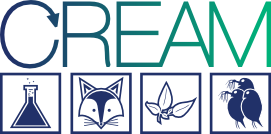Overview of CREAM contributions to SETAC Europe 15 – 19 May 2011 in Milan, Italy
Short course 18
May 15th – Population models for ecological risk assessment: introduction to the documentation framework TRACE
Instructors: Volker Grimm, Jürgen Gröneveld, Nika Galic, Pernille Thorbek.
PE02P Poster session
May 16th – PBPK modelling in ecological risk assessment
- Anna-Maija Ruotsalainen, Kristin Schirmer, Roman Ashauer (Dübendorf, Switzerland)
Toxicokinetic-toxicodynamic (TKTD) modelling of survival of Gammarus pulex following exposure to multiple pulses of the fungicide propiconazole
Abstract Code MO 317 - Julita Stadnicka, Kristin Schirmer, Roman Ashauer (Dübendorf, Switzerland)
Predicting internal concentrations of chemicals in fish based on PBPK and one-compartment models
Abstract Code MO 320
ET10P Poster session
May 16th – Linking chemical residues with biological responses in wildlife
- Béatrice Hernout, Kate Somerwill, Kathryn Arnold, Colin McClean ,Volker Grimm, Alistair Boxall (York, United Kingdom)
Predicting exposure of bats to soil-associated heavy metals
Abstract Code MO 146
ET16P Poster session
May 16th – Soil ecotoxicology and quality assessment
- Juergen Schmidt, Mattia Meli, Annemette Palmqvist, Valery Forbes (Roskilde, Denmark)
Life table response experiments with two species of Collembola
Abstract Code MO 195
ET04
May 17th – Ecological relevant endpoints
- Annika Agatz, Roman Ashauer, Colin Brown (York, United Kingdom)
Effects at a daily resolution of imidacloprid on the individual feeding activity of Gammarus pulex (L.)
ET11A
May 19th – Mechanistic modelling for risk assessment: sub-lethal responses and population-level effects
- Agnieszka Hunka, Amalie Thit, Annemette Palmqvist, Pernille Thorbek, Valery Forbes (Roskilde, Denmark)
A matter of trust – stakeholders’ perspectives on ecological modelling.
Abstract Code ET11A-1
ET11B
May 19th – Mechanistic modelling for risk assessment: sub-lethal responses and population-level effects
- Elke Zimmer, Tjalling Jager, Virginie Ducrot (Amsterdam, Nederland)
Juvenile food limitation: ecotoxicologists, be warned!
Abstract Code ET11B-2 - Katarzyna Matuszewska, Tomasz Kułakowski, Richard Sibly (Reading, United Kingdom)
An agent-based model of woodpigeon populations and its use for risk assessment
Abstract Code ET11B-4 - Volker Grimm, Amelie Schmolke, Donald DeAngelis, Pernille Thorbek (Leipzig, Germany)
Towards good modelling practice: TRACE, a standard for documenting ecological modelling in chemical risk assessment
Abstract Code ET11B-5
ET11P Poster session
May 19th – Mechanistic modelling for risk assessment: sub-lethal responses and population-level effects
- Tomasz Kulakowski, Katarzyna Matuszewska, Richard Sibly, Mark Beaumont (Reading, United Kingdom)
Bayesian calibration and evaluation of agent-based models: a case study of a skylark population model for pesticide risk assessment.
Abstract Code TH 147 - Martin, Benjamin, Zimmer, Elke, Grimm, Volker, Jager, Tjalling (Leipzig, Germany)
Dynamic energy budget theory meets individual-based modelling: a generic and accessible implementation for population risk assessment.
Abstract Code TH 148 - Natnael Hamda, Dragan Jevtic, Ryszard Laskowski (Krakow, Poland)
Decomposition analysis of LTREs may help to design short-term ecotoxicological tests: population modelling approach.
Abstract Code TH 152 - Jacqueline Augusiak, Noël Diepens, Hans Baveco, Paul Van den Brink (Wageningen, The Netherlands)
Correlated random walk as mode of short distance dispersal for Asellus aquaticus – an experimental approach for model parameterization.
Abstract Code TH 153
- Faten Gabsi, Thomas G. Preuss (Aachen, Germany)
The importance of maternal environment in determining offspring size in Daphnia magna population models. Abstract Code TH 154 - Chun Liu, Richard Sibly, P Edwards, R Murfitt, Pernille Thorbek (Bracknell, United Kingdom)
Ecological risk assessment of pesticides on wood mouse populations using individual-based models. Abstract Code TH 156 - Mattia Meli, Juergen Schmidt, Annemette Palmqvist, Valery Forbes, Volker Grimm, (Roskilde, Denmark)
An IBM to explore the effect of local variability in soil contamination levels on population dynamics of Folsomia candida.
Abstract Code TH 161 - Devdutt Kulkarni, Andre Gergs, Udo Hommen, Thomas G. Preuss (Aachen, Germany)
Why a population model of the cyclopoid copepod Mesocyclops leuckarti for the ecological risk assessment of chemicals is absolutely necessary.
Abstract code TH 163 - Lara Ibrahim, Thomas G. Preuss, Udo Hommen (Aachen, Germany)
Screening for realistic worst-case species of freshwater fish for pesticide risk assessment in edge-of-field water bodies in the EU.
Abstract code TH 164

